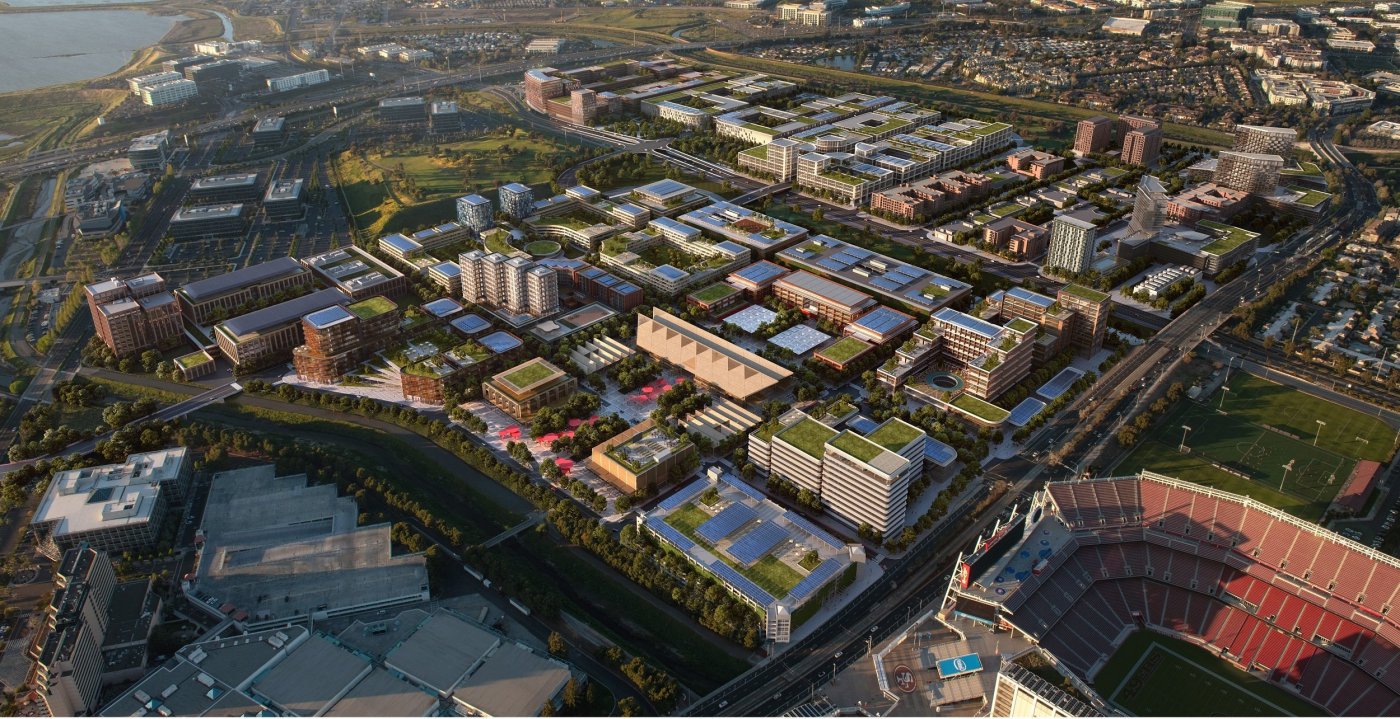
As the Silicon Valley office market struggles to rebound from the pandemic, developers behind a massive mixed-use village in Santa Clara are looking to pivot, potentially swapping out office space for industrial uses like warehouses and data centers.
Located across the street from Levi’s Stadium on 240 acres of mostly vacant city-owned land, the Related Companies are looking to build more than 9 million square feet of new homes, shops, restaurants, hotels and offices in what is expected to become a regional entertainment hub.
Related Articles
Oakland hotel is seized by lender as Bay Area lodging market fades
Downtown San Jose housing tower lurches into default
Two data centers may sprout in San Jose to help meet needs of AI tech boom
Historic South Bay building is bought as office market stays frail
Santana Row in San Jose is poised to produce its first housing in a decade
But the project, which was approved by the Santa Clara City Council in 2016, has faced a number of unexpected delays, including a lawsuit from the city of San Jose, escalating construction costs and regulatory challenges over remediating a part of the site that once housed a landfill. The latest quandary — a stagnant office market in which vacancy rates sit at around 16% in Silicon Valley overall and even higher in places like downtown San Jose — has created further challenges for a project that has yet to get shovels into the ground.
On Tuesday evening, the council approved a new option for the mega-development that could solve some of its woes. Instead of building roughly 4 million square feet of offices on the northeastern section of the project, Related wants to put in 1.6 million square feet of industrial or manufacturing space. The offices are expected to be transferred to the part of the project known as the City Center — the heart of the development that will serve as the main entertainment core.
Nicholas Vanderboom, the chief operating officer of Related California, told the council that the new plan will allow them to adapt to the changing market, which he said has been demanding more space for manufacturing and industrial uses including data centers.
“We also think that consolidating the office into the City Center will ultimately help us with the feasibility, because that’s the type of office that really is in demand,” he said. “It’s not the office campus environment today, it’s the downtown, walkable mixed-use environment where office space is leasing, whether that’s Santana Row or downtown Sunnyvale.”
The council’s approval of the new scheme gives the developer more flexibility to proceed in a challenging development market. If conditions shift and office space is once again in demand, Related can move forward with the previous plan approved in 2016.
“Hopefully six months from now, a year from now, we’ll start to see an office market come back, we’ll start to see a hotel market come back,” said Steve Eimer, executive vice president of Related. “It’s happened before and we believe it will happen again. We want to be there to take advantage of it.”
Santa Clara Mayor Lisa Gillmor called the new plans a “proactive response to the changing market demands,” and said she hopes that it will help trigger the development of the City Center part of the vision.
“With this project, we will finish the Live Work Play puzzle that we’ve been working on for decades,” she said.
Not all of the council, however, was amendable to the new changes, with Councilmembers Raj Chahal, Kevin Park and Suds Jain casting the dissenting votes on Tuesday.
Along with the additional plans, the council approved amendments to the development agreement, which included increasing the percentage of affordable homes the developer must build from 10% to 15% of total units and deepening the level of affordability from 120% of the area median income to 100% — an annual income of $195,000 for a family of four.
The development agreement — a 30-year contract that allows for the build-out of the project in phases — also dictates certain fees the city will receive from the developers. Given the delays and the potential pivot, Chahal said the city should be trying “to get better buck for our land value.”
“The land belongs to all of us, to all of the residents,” he said. “If there’s a chance we can do that, if the developer is having a benefit of changing the zoning from office space to data centers, we should be getting something more.”
Jain, who has pushed the city to adopt more environmentally friendly policies, wanted to require that any data center that Related adds on the site will use 100% carbon-free electricity — a proposal that was shot down by the majority of the council. Santa Clara has become a hub for data centers over the years — to the point that the more than 50 data centers now consume roughly 60% of the city’s energy through its utility company, Silicon Valley Power.
“The fact that the city did not benefit over all that time is a problem for me,” Jain said of the delays. “Everyone sees that data centers are becoming increasingly a huge problem for climate change and the carbon impacts of data centers is immense. Most of the large companies have commitments to having carbon free electricity for their data center and becoming carbon neutral businesses.”